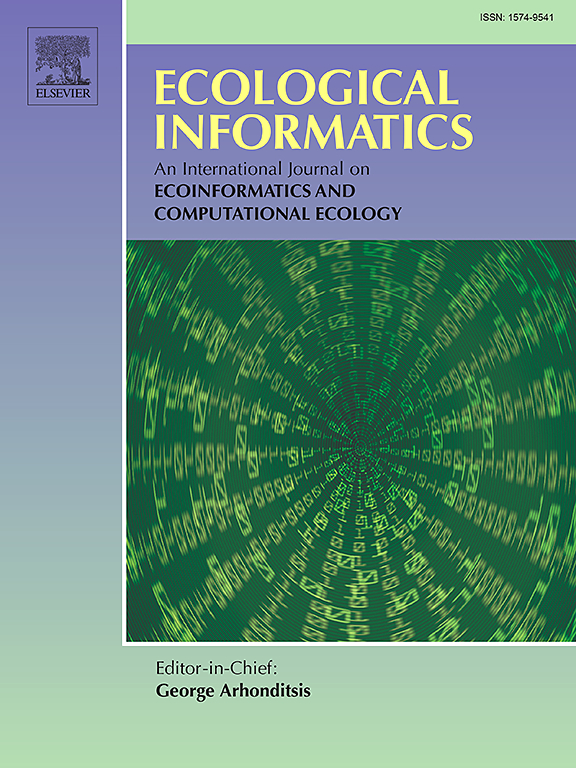An adaptive method for individual tree segmentation synthesizing canopy cover and competitive mechanism using UAV data
IF 7.3
2区 环境科学与生态学
Q1 ECOLOGY
引用次数: 0
Abstract
Accurate individual tree segmentation (ITS) is crucial for precision forestry and small-scale carbon sink accounting; however, canopy overlap in complex forest stands—particularly in northern plantations, presents substantial challenges for conducting ITS using LiDAR point cloud. This study introduces an adaptive ITS method that incorporates canopy cover as the primary constraint in marker-controlled watershed segmentation. This addresses two typical segmentation biases: low canopy cover areas that are prone to under-segmentation are refined using the DBSCAN spatial clustering to recover missed tree boundaries, whereas high canopy cover regions that were prone to over-segmentation were optimized using Hegyi index-enhanced improved K-means clustering method of raw point cloud data for context-aware region merging. By fusing the canopy height model (CHM) efficiency for rapid canopy contour extraction with point cloud-derived 3D structural details, this “cover-degree-driven, scene-adaptive” method balances computational speed and segmentation precision. The method was validated across 28 plots, the method achieving F1 scores of 0.89–0.95 for four tree species and outperforming traditional ITS methods in mixed forests with F1 improvements of 0.12–0.24. This method enhances the ITS accuracy of individual tree aboveground biomass estimation, thereby directly facilitating efficient small-scale carbon accounting, streamlined forest inventories, and sustainable precision management in complex ecosystems.
基于无人机数据综合树冠覆盖度和竞争机制的单树分割方法
准确的单树分割(ITS)是精确林业和小规模碳汇核算的关键。然而,在复杂的林分中,特别是在北部的人工林中,冠层重叠对使用激光雷达点云进行ITS提出了实质性的挑战。本文介绍了一种自适应ITS方法,该方法将冠层覆盖度作为标记控制分水岭分割的主要约束条件。该方法解决了两种典型的分割偏差:使用DBSCAN空间聚类方法对容易分割不足的低冠层覆盖区域进行优化,以恢复缺失的树木边界;而使用Hegyi指数增强的改进K-means原始点云数据聚类方法对容易分割过度的高冠层覆盖区域进行优化,以进行上下文感知区域合并。通过将快速提取冠层轮廓的冠层高度模型(CHM)效率与点云衍生的三维结构细节相融合,这种“覆盖度驱动、场景自适应”的方法平衡了计算速度和分割精度。结果表明,该方法在28个样地的F1得分为0.89 ~ 0.95,在混交林中优于传统ITS方法,F1得分提高了0.12 ~ 0.24。该方法提高了单株树木地上生物量估算的ITS精度,从而直接促进了高效的小规模碳核算,简化了森林清单,并在复杂生态系统中实现了可持续的精确管理。
本文章由计算机程序翻译,如有差异,请以英文原文为准。
求助全文
约1分钟内获得全文
求助全文
来源期刊

Ecological Informatics
环境科学-生态学
CiteScore
8.30
自引率
11.80%
发文量
346
审稿时长
46 days
期刊介绍:
The journal Ecological Informatics is devoted to the publication of high quality, peer-reviewed articles on all aspects of computational ecology, data science and biogeography. The scope of the journal takes into account the data-intensive nature of ecology, the growing capacity of information technology to access, harness and leverage complex data as well as the critical need for informing sustainable management in view of global environmental and climate change.
The nature of the journal is interdisciplinary at the crossover between ecology and informatics. It focuses on novel concepts and techniques for image- and genome-based monitoring and interpretation, sensor- and multimedia-based data acquisition, internet-based data archiving and sharing, data assimilation, modelling and prediction of ecological data.
 求助内容:
求助内容: 应助结果提醒方式:
应助结果提醒方式:


